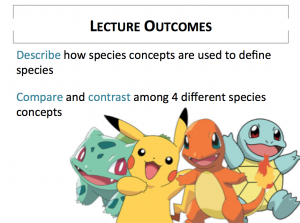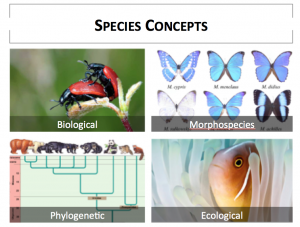Species Concepts – Post Teaching Reflection
February 17th, 2017 – Two Guest Lectures – Biology 121 Ecology, Evolution and Behaviour
This semester, I took the opportunity to run a SoTL project by teaching two sections of the same class back to back. The topic of the lesson was Species Concepts, and was an excellent topic for my SoTL for a few reasons: 1) I am already quite comfortable with the content which allowed for more time to explore ways in which to convey the material; and 2) there was already a baseline activity being used by other experienced instructors that I was able to adapt to best fit the purposes of this lesson.
For my SoTL project, I was interested in evaluating how knowledge retention compares between a lesson focused on lecture vs a lesson that is primarily focused on active learning.


The Setup:
Lesson 1 – This lesson was structured similar to a lecture I would give in a first year class. As such, there was already some incorporation of active learning. Learners were provided with a course outline in advance of the lesson, which they could fill in during the lesson. Additionally, learners were given the opportunity to answer three clicker questions. For one of these questions, learners were asked to first discuss the question with their neighbour before voting.
Species Concepts Lesson Outline
Lesson 2 – Learners were given an “abbreviated” lecture and received the same outline as was given in Lesson 1. Learners in this lesson were also given the same clicker question used at the start of the first lesson to serve as a pre-assessment. The lecture component lasted approximately 20 minutes, leaving 35 minutes for a jigsaw activity. In this activity, students formed groups of 4. Each learner chose a species concept in which to be a specialist. Specialists were asked to go to different areas of the room where they were given a handout with information about a group of organisms. Using that information, they were asked to discuss and determine in their specialist groups, whether those organisms best fit the description of one or more species based on their species concept. Learners then returned to their original groups of 4, and discussed what each of the specialist groups decided and then determined, overall, whether they believed the organisms to be 1 or more species based on the cumulative “specialist knowledge” of the group. We finished with a brief group discussion to determine which pieces of information learners valued over others when making their decisions.
Challenges and Lessons Learned:
Timing – Lesson 1 – I planned for this lesson to run 45 minutes. I practiced it twice and was fairly confident that I wouldn’t run over 50 minutes, even after making allowances for extra time for learner questions. Wrong. With only about 5 minutes left, I was just starting on the final species concept. As a result I had to skip the final clicker question I had designed, which is unfortunate, because I believe it would have been a good post-assessment. In future, I would redesign the lecture so that it did not include prezygotic and postzygotic modes of reproductive isolation and instead move that topic to the following lesson on speciation.
Lesson 2 – Because of an issue I will expand on under “Outlines for functionally different lessons” below, the lecture component of this lesson ran over time by about 7 minutes. As a result, I needed to cut time from the activity. Originally, specialist groups were supposed to convene for 15 minutes – this was changed to 10. Learners then had 10 minutes in their original groups, and we were left with about 5 minutes for a class discussion. If I were to re-allocate timing in future, I would have dedicated 10 minutes for discussion in order to take time to clear up misconceptions and give a stronger summary of what was covered in class.
Come-to-Science Moment: I have consistently run longer in lectures than I think I will. That means I should plan a shorter lesson. In case I end up running short on time, I can always include additional slides that may not be necessary for learners to get to, but would help clarify any points in the lesson. In this way, if we get to them, great. If not, pas de problem.
Outlines for functionally different lessons – Perhaps the largest oversight from having these lessons run back to back, was using the same outline for each lesson. I had originally used the same outline because I wanted to ensure that learners in both lessons were provided with the same content. It was, as I realized a bit too late, impossible to fill in the same content for both lessons in a third of the time for the second section, even though I had removed most of the examples used in the first lesson.
Come-to-Science Moment: In future, I could keep the outlines the same, however, for the second section, provide more of the information already “filled in” on the outline. Specifically, I think that if I were to run these sessions again, I would make it so that the second section had the “advantages” and “disadvantages” for each species concept provided to them on the outline so that we did not have to fill them in together as a class.
Activity Design – The activity we used in the second lesson has a lot of potential to be a very effective teaching tool. The biggest omission here was that there was not enough time to get into a class discussion around how species concepts can be used and integrated to determine whether groups of organisms are one or more species. I worry that learners left with an incomplete understanding of how scientists integrate all of these concepts when making species determinations.
Come-to-Science Moment: There are a few things we could do in future to provide more time for a discussion and expose learners to the complexity of this issue. First, would be, as I mentioned previously, to run a shorter “lecture component”. Learners are expected to have done their pre-reading and therefore should already have an understanding of much of what we covered in the first part of the lesson. We could expand the pre-lesson quiz to get a sense of learners’ understanding of the different concepts. Another thing we would change would be to provide learners with the information they received in their specialist groups in advance. That way less time would be necessary for students to read through this content in class. We could have learners jot down their reason in advance for why they believe the example represents one or more species, highlighting the specific content that led them to their decision.
Classroom Management – This was the first time I experienced significant classroom “chitchat” in the background of one of my lessons. It was distracting and I became flustered. I tried to direct my attention to groups of students I noticed talking (which did help momentarily) and by asking learners to please not have conversations while I was speaking.
Come-to-Science Moment: In future I would say something sooner, and I would clearly state that I expect learners to keep their talking to a minimum.
Next Steps:
We are performing a post-assessment of knowledge retention this week. It will have been just over one week since learners were in these lessons. We will be asking questions about how the activity/lecture helped their learning and why, as well as a few questions geared at how well students can recall and interpret the lesson content. I’m looking forward to reviewing their responses to: 1) compare understanding across lessons; and 2) compare perceived value of the lesson for learning.
I would like to run this SoTL again, and I believe that, given some edits, this activity could be an excellent way to engage learners. This is also the first time I have employed a jigsaw in the classroom, and I am looking forward to using this technique again in future.
